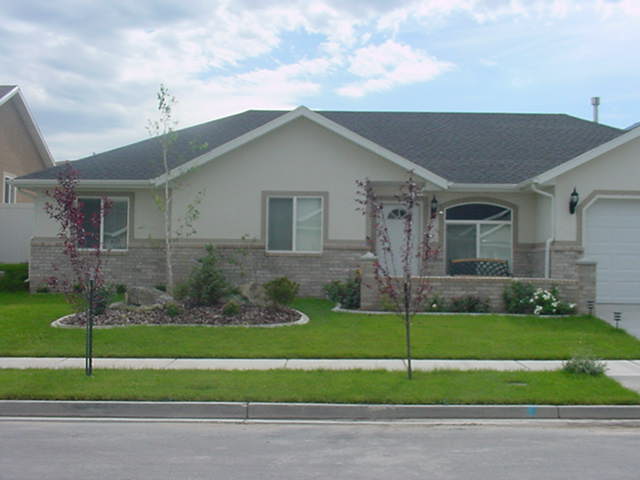
-by Elyssa Andrus – Daily Herald
PAYSON – Even now, the smell of sagebrush turns her stomach. It reminds her of that day 24 years ago, when she lay in a patch of brush after an automobile accident, losing consciousness, soon to find she was a paraplegic. Monica Wayman took her last unaided steps on August 4, 1979, at age 16. Decades later, it is a date she remembers clearly. It was supposed to be her wedding day. Now, March 30 will mark a new, more hopeful anniversary: the day Wayman and her children moved into their first home. One they built from the foundation up, with their own hands.
Wayman, of Payson, is one of dozens of low-income Utah Valley residents to build their own home through a program sponsored by the local nonprofit Rural Housing Development Corporation. The program, called mutual self-help housing, puts together teams of qualifying families to construct one another’s homes, laboring together until each is completed. This “sweat equity” program allows participants to obtain reduced mortgages at low interest rates, making payments on the homes that are comparable to the cost of rent, typically between $450 and $850.
For Wayman, a single mother of three who supports her family with an Internet sales business, home ownership has been elusive. Since moving out of her parents’ house at age 16, she has lived in dozens of rented apartments, homes and condominiums, some with stairs that the wheelchair-bound Wayman could never climb.
“I kept telling the kids, we’re going to have a house, no matter what. I’ll figure it out,” Wayman said. “But in my head, I was going, “There’s no way.”
But the self described optimist has faced many challenges in her life, challenges more difficult than securing housing. And if heartbreaking adversity has taught her one thing, it is that, with enough perseverance, the bitter sometimes yields to the sweet.
“I’m very stubborn and determined,” she said “You tell me I can’t do it, I say watch me.”
Loss and worse
As a child and teenager; Wayman loved to run, to ride horses, to walk the acres of the pastoral land in the farming community of Payson. In August 1979, the attractive, blue-eyed, red-haired 16-year old and her future husband, Craig, then 18, were driving to Las Vegas to be married.
On a patchy strip of highway, the ’79 GMC truck hit a hole in the road, Wayman overcorrected, the truck rolled.
Craig Wayman, the passenger walked away from the accident. Monica Wayman shot through the front window of the truck, then sailed nearly the length of a football field before landing in sagebrush.
At the time she was three months pregnant.
Miraculously, Wayman and her unborn child survived the crash, although Wayman’s lungs collapsed and her spine shattered in several places. She would spend weeks in the intensive care unit, her 5-foot, 9-inch body withering from 104 pounds to a skeletal 72. The accident left her unable to walk.
Recovery came slowly, painfully, as Wayman learned to perform simple tasks like dressing, sitting up and combing her hair again. Eventually she was released from the hospital and in October 1979, Monica and Craig married.
Five months after the accident their first child, a baby boy, was born with severe brain damage, likely related to the crash. He lived two days.
The tragedies over-whelmed Wayman.
“There were times when I just thought, why me?” she said. “I was so active. …For me to go into a chair and not be able to function was just crazy. It was kind of a joke.”
After the death of her infant son, Wayman enrolled at Payson High School and earned her diploma. She later studied accounting at Utah Valley State College. She had three healthy children and two marriages. The first marriage lasted 11 years, the second, 45 days.
Wayman learned to drive a car again, to maneuver unaided, things that had seemed effortless before the accident.
Two decades after the crash, Wayman’s youngest daughter, 11-year old Wendi, says she can’t picture her mother out of a wheelchair. But in Wayman’s dreams she is always walking.
A new foundation
As part of Rural Housing Development Corporation’s requirements, recipient families typically work 30 hours a week until their homes are completed.
Because of her disability, Wayman was unable to perform much of the hard labor. In her stead, her father Dick Jones, along with her former sister-in-law, Rebecca Neal, and her 20-year old daughter, Kelli, completed the requisite 30 hours a week of home building.
In roughly 10 months, the group built 10 homes, watching the structures evolve from skeletal frames to sturdy brick and stucco structures.
Neighbor worked with neighbor in a sort of modern barn raising. Kelli said she enjoyed shingling roofs, although the heat of the summer sun often left her exhausted.
Other times the work was frustrating, as little things – a missed measurement, a delayed shipment – slowed progress to a standstill.
As others framed and shingled, Wayman performed administrative duties such as keeping track of hours and helping schedule sub-contractors.
In her own, wheelchair accessible home, Wayman painted sanded and installed doorknobs. But being unable to pound nails and saw two-by-fours was at times maddeningly defeating, she said.
For everyone, the program is an “up-and-down experience emotionally,” said Brad Bishop, Executive Director of the Rural Housing Development Corporation. So far, the organization has completed 30 houses in Payson. Another 20 are in the works in Payson and Salem.
Ultimately, the finished products are impressive, said Neal, a 32-year-old mother of two.
“We built 10 homes,” she said. “That is pretty neat for a bunch of schmoes, most of us having no building experience.”
Wayman’s home was the first of Rural Housing Development Corporation’s to be specifically modified for a wheelchair user. The home’s doors are wider; the master-bathroom has a specially designed shower. Hunter-green carpet and dark brown linoleum hide wheelchair tracks. A double-sided mailbox allows Wayman to check the post without navigating the icy driveway in the winter.
Settling down
Nearly two years after Wayman began the process of applying for her new home, the house has passed inspection. It is hers. The family’s belongings are nearly unpacked.
Wendi, an 11-year-old with wispy blond hair and an abundance of energy that sometimes leads to fidgeting, gives frequent tours of the home, pointing out the beautiful bathroom,” “the beautiful pantry.” Her 14-year-old brother, Jesse’s, bedroom is decorated, wall-to-wall with skateboarding posters.
As the family finishes the final unpacking, the children talk about what they considered the ultimate luxury; permanence. Leaving books unpacked, not in boxes. Putting holes in the walls for posters if you want to. Making – and keeping – neighborhood friends.
Kelli, 20, is a Brigham Young University student and lives in an apartment. But her frequent moves as a child make her also yearn for stability.
“I’m never marrying a guy that has to move in the Army,” Kelli said. “I’ll be like, Oh; you’re in the Army – all right, see you later.”
Wendi has loftier goals, “I want a guy that already has a house.”
Wayman has taken to telling friends that the only way she’ll move again is if she wins a $10 million sweepstakes. Then, and only then, she’ll consider an upgrade.
Already, this house has its memories: Here is the roof Kelli shingled, the cabinet Wendi installed, the door-knob Monica put in place.
“It’s nice that this is kind of the final chapter,” Neal said. “Monica has a home that’s hers and always will be.”
As the family continues settling in, Wendi, bubbling over with energy, can’t wait any longer. She goes outside and dances on the brick wall surrounding her new house.
Nearby, a group of girls comes over to join her, then trail off down the street. She follows them excitedly, happily, but every so often she turns her gaze backward.
Her new home, her first home, is still in sight.

